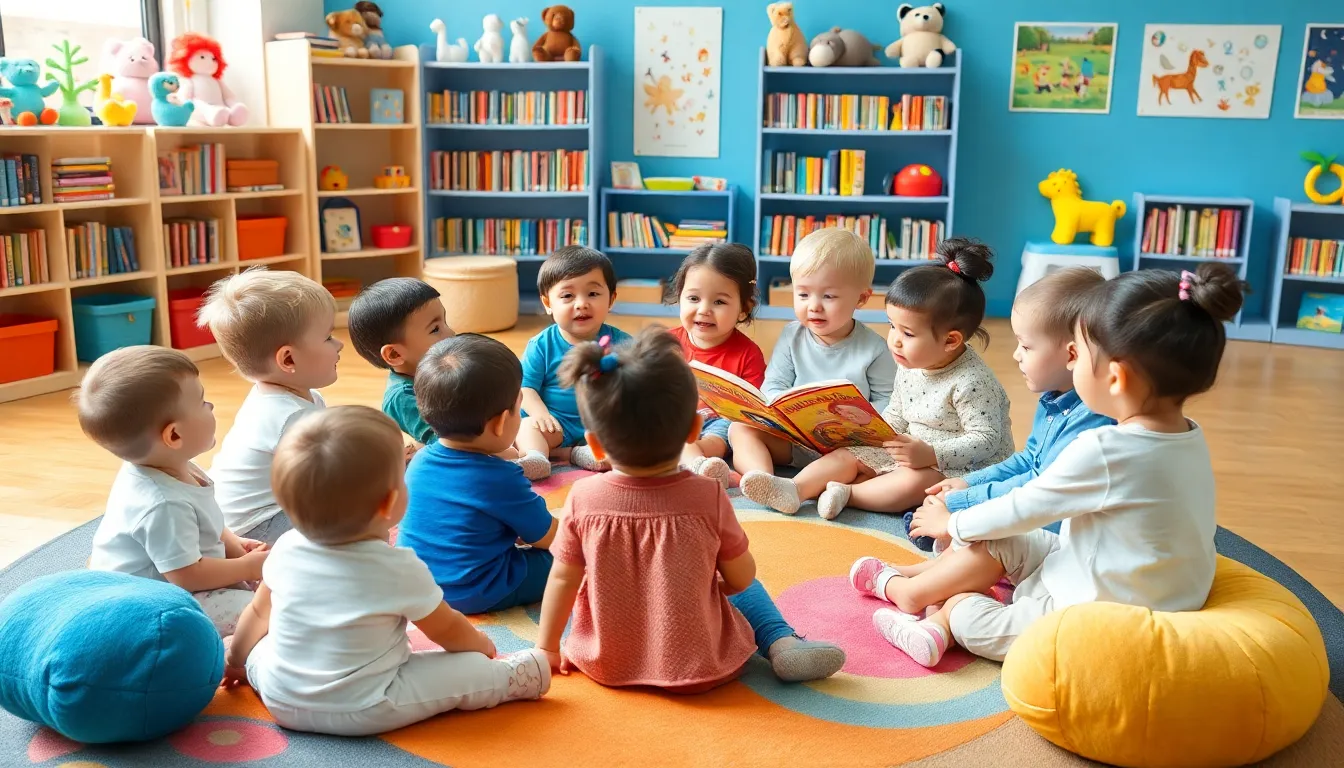In a world where toddlers can turn a simple snack into a three-hour adventure, storytime offers a magical escape. Imagine a cozy corner filled with tiny listeners, their eyes wide with wonder, as they dive into tales of brave animals and daring princesses. It’s not just about reading; it’s about sparking imagination and creating connections.
What Is Toddler Storytime?
Toddler storytime serves as a structured activity designed for young children, typically ranging from 1 to 3 years old. It provides an opportunity for caregivers and children to gather and enjoy stories together. Storytime often takes place in libraries, classrooms, or community centers, creating a shared space for learning and interaction.
Engaging narratives, colorful illustrations, and cheerful puppets characterize toddler storytime sessions. Each story encourages imagination while capturing attention. Rhythm and repetition often play crucial roles, enhancing language development and comprehension skills in toddlers.
Participatory elements, such as songs and finger plays, enrich the experience, fostering movement and interaction. Children may clap, dance, or mimic actions, which contributes to their motor skill development. The dynamic involvement helps maintain focus and makes the stories more memorable.
Facilitators play an essential role in guiding toddler storytime. They often select age-appropriate books that resonate with the interests and developmental stages of young listeners. Effective facilitators create a warm environment, inviting questions and encouraging responses from the children.
Many benefits accompany toddler storytime. Cognitive skills, such as vocabulary growth and listening skills, are significantly enhanced through regular participation. Social skills also develop, as children learn to share attention and engage with peers.
These interactive sessions cultivate a love of reading from an early age, establishing lifelong learning habits. By creating a positive association with books, toddlers become more likely to explore literature independently in the future. Ultimately, toddler storytime stands as a vital tool in early childhood development, blending education with entertainment.
Benefits Of Toddler Storytime

Toddler storytime offers several significant benefits that contribute to early childhood development. These sessions empower children to engage with books in enriching ways.
Language Development
Language development thrives during toddler storytime. Exposure to diverse vocabulary occurs as toddlers listen to various stories. Engaging narratives introduce new words, enhancing vocabulary and comprehension skills. Rhythmic patterns and repetition found in the stories promote phonemic awareness. Participatory elements, such as songs, enhance auditory learning and create memorable experiences. Improved listening skills manifest as children become active listeners, following along with the story. Facilitators encourage toddlers to express thoughts and feelings, fostering verbal communication. Overall, these interactive sessions lay the foundation for strong language skills essential for reading readiness.
Social Skills
Social skills flourish through toddler storytime interactions. Shared experiences foster connections among peers as they listen and respond to stories together. Engaging in group activities, like songs and finger plays, promotes cooperation and teamwork. Toddlers practice taking turns and sharing opinions in a safe environment. These interactions support emotional development as children learn to express empathy and understand others’ feelings. The supportive atmosphere created by facilitators encourages toddlers to ask questions and participate actively. Thus, the communal aspect of storytime strengthens social bonds and builds confidence in young children.
Tips For Effective Toddler Storytime
Selecting appropriate materials boosts engagement and learning. Choose books with vibrant illustrations and simple narratives that align with toddlers’ interests. Look for titles that encourage interaction, such as those featuring repetitive phrases or questions prompting responses. Opt for stories highlighting themes of exploration, friendship, and adventure to captivate young imaginations.
Incorporating activities adds excitement to storytime. Use songs and finger plays to complement the narratives, enhancing auditory and kinesthetic learning. Introduce props like puppets or stuffed animals, as they create visual and tactile connections to the story. Encourage movement through simple actions related to the plot, fostering physical engagement and fun. Use storytelling techniques such as voice variations and expressions to make the experience lively.
Creating The Perfect Storytime Environment
Creating an ideal storytime environment is essential for engaging toddlers. A cozy, inviting space encourages participation and fosters imagination. Soft lighting helps set a relaxing atmosphere, while comfortable seating allows toddlers to settle in.
Moreover, incorporating colorful decorations can capture attention. Use posters or murals featuring beloved characters or themes from popular stories. Age-appropriate cushions or mats provide a safe area for little ones to move around during interactive segments.
In addition, background music can enhance the ambiance. Soft, playful tunes stimulate enjoyment without overwhelming the stories presented. Facilitators may choose to play instrumental music to create a soothing backdrop that promotes focus.
Establishing a routine promotes familiarity and comfort. Starting each session similarly helps toddlers anticipate what’s next, reducing anxiety about the unknown. For example, opening with a familiar song creates a welcoming atmosphere.
Interactive props serve to enhance storytelling. Props like puppets, plush toys, or story-related items visually stimulate toddlers and encourage them to engage with the narrative. For instance, introducing a puppet during a story makes the experience more memorable.
Facilitators can also invite toddlers to participate verbally. Asking questions about the story encourages them to think critically and express their thoughts. Simple prompts can inspire responses that enhance comprehension.
Comfort and safety play crucial roles in the environment. Ensuring the space is child-proof fosters peace of mind for caregivers. Supervision remains key during the sessions, allowing facilitators to promptly address any needs or concerns.
Ultimately, a well-crafted storytime environment enriches the experience for toddlers, enhancing their engagement and enjoyment of literature.
Toddler storytime is more than just reading books; it’s a magical experience that nurtures a child’s growth. By immersing toddlers in engaging narratives and interactive elements, these sessions cultivate a love for literature and enhance essential skills.
The carefully curated environment and thoughtful selection of materials create a welcoming space where toddlers feel comfortable to explore and express themselves. As they listen to stories and participate in activities, they develop language, social skills, and a sense of community.
Ultimately, toddler storytime lays the foundation for a lifelong journey of learning and imagination, making it an invaluable part of early childhood development.
